As a result of the intrusion of the Kimmerians and Scythians from southern Russia in the late eighth and seventh centuries B.C., the entire political and military structure of western Iran and Anatolia was overturned. Urartu, Assyria’s chief enemy in eastern Anatolia, was destroyed; Phrygia was overrun; and for a quarter of a century the Scythians ruled in Mannai (modern Kurdistan, Iran). With two University Museum expeditions working in the areas concerned– one at Gordion, capital of Phrygia, the other at Hasanlu, a frontier fortress of the Mannaeans– these events hold a special interest for our readers. The question of where these invading peoples originated and what made them suddenly erupt from South Russia through the Caucasus in the Near East has long been a major archaeological problem. Some of the background to this problem, developed as the result of recent Soviet excavations, is given in the following article by Marija Gimbutas. The article is a preview of a comprehensive review of the subject in a book to be titled “Prehistory of Eastern Europe.”–EDITOR
Large-scale excavations in the USSR during the last decades have revealed a series of new cultures and have added much new information about those previously known. Of the latter, one which has proved to be of considerable importance nad power is that of the “Timber-grave” people, which expanded in southern Russia during the Bronze Age and is now generally accepted as representing the Early (or Proto) Scythian culture.
The name “Timber-grave” is derived from the type of grave. In Russian it is called srubna, from srub meaning timber. Actually, the term refers to the western portion of an extensive cultural platform distributed over the steppe-forest and steppe zoned from southern Russia in the west to the upper Yenisei River in the east. In southern Siberia this wide-spread Eurasian culture of the Bronze Age is called the “Andronovo Culture.” The western variant, or Timber-grave Culture, differs from the Andronovo proper because of its influences from the Caucasus and the Black Sea area which resulted in the development of distinctive western features.
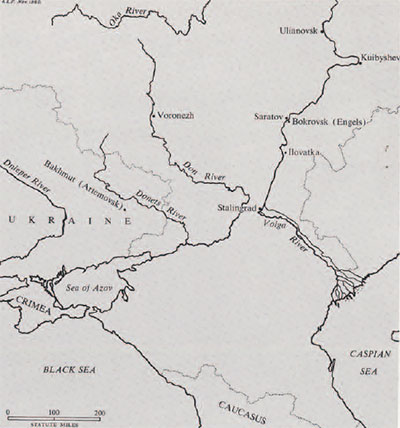
In a precise geographical sense, Timber-grave sites are confined to southern Russia. They are not found in the Ukraine, except during the Late Timber-grave period when a westward expansion to the lower Dnieper River area took place. Sites, in general, are concentrated in the lower and middle Volga basin (Fig. 1). This is one of the best explored areas in Russia, particularly intensive excavations having been made there in the fifties. Voluminous monographs appeared in 1954, 1958, and 1959 (Materialy i Isledovaniia po Arkheologii SSSR, Nos. 42, 60, and 61) in which the results of the Kuibyshev Expedition of 1950-1954 and the Stalingrad Expedition of 1951-1955 were published. The monographs include good reports on Chalcolithic, Bronze, and Iron Age finds by N. IA. Merpert, A. Kh. Khalikov, K.F. Smirnov, I. V. Sinitsyn, A.E. Alikhova, N.V. Trubnikova, V.P. Shilov, and others.
The number of excavated habitation sites with the remains of dwellings has rapidly increased since World War II, although discoveries of barrows or kurgans including timber-graves of various periods are predominant among all other finds. At present, excavated materials have tripled in quantity in comparison to what was at hand at the beginning of this century, during the time of Gorodtsov, who excavated in the basins of the Don and Donets Rivers. In 1926, when A.M. Tallgren published his Pontide Prescythique, he could use as primary sources only Gorodtsov’s reports, Rykov’s materials from 1924-1926 excavations at the cemetery of Pokrovsk (Engels) near Saratov, and reports of a few isolated finds and hoards, such as Sosnovaia Maza, made before World War I.
The new excavations allow a much better understanding of the nature of the Timber-grave Culture and its origins. It has its roots in the local Neolithic Pit-grave and Chalcolithic Hut-grave Cultures of southern Russia. Particularly in the lower Volga area there is a clear continuity from the Chalcolithic Hut-grave Culture of the early second millennium B.C. The continuity is recognizable in the gradual changes perceptible in the economy, technology, and inferred social structure, and in the persistence of burial and other religious rites as well as in physical type. During the nineteenth or eighteenth century B.C. signs of local metallurgy appeared and flat-bottomed vessels replaced the ancient round-based pots. From this period the Timber-grave Culture developed continuously through an Early, Classical, and Late stage to the beginning of the Scythian era in the first millennium B.C.
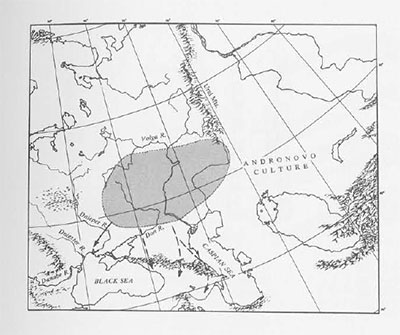
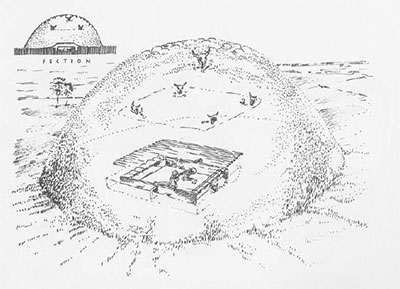
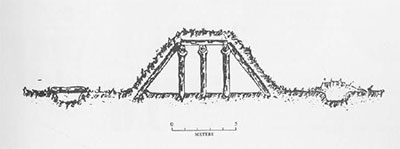
Settlements of the Timber-grave Culture are found on the terraces of both large and small rivers. At one site only about ten houses were found, and the settlement pattern was irregular. The number of families living in one village probably did not exceed twenty, comprising perhaps one to two hundred people. The houses were semi-subterranean and rectangular in plan. They ranged in size from fifteen to twenty-five feet in length in the Early and Classical periods to sixty-five feet and more in length during the Late period.
Timber-grave people were far from being steppe nomads as they are frequently pictured. Stock breeding and farming were their basic occupations, although only small areas in the river valleys were suitable for growing grain. The latter activity is indicated by remains of wheat and millet. A large percentage of several kinds of weed seeds among those of wheat and millet shows that the same fields were used for a considerable time. Tools usable in farming were found in nearly every habitation site. Stone objects include pestles, flat oval querns, round rubbing stones, and hoe-like objects. Chisel-like tools of copper, fairly long and having a broad edge, may have been the ends of hoes. Copper sickles are common in habitation sites, graves, and hoards. Pestles were laid in women’s graves. In northern sites, like those in the district of Kuibyshev which is forested, traces of forest clearing have been found. Hunting in these forests was probably only a secondary source of livelihood as indicated by the very small numbers of wild animal bones as compared with those of domesticated animals. In nearly all excavations the largest percentage of bones belonged to cattle, smaller percentages to sheep and horses, and the least to pigs. Horse bones regularly appear in the habitation sites among food remains. In addition, the camel was known. Almost no evidence of fishing was found.
Clearly, meat and milk products played an important role in diet. In the better explored sites deep storage pits containing pots with the remains of meat inside were found under the dwellings. Other pots with strainers which may have been used for milk products were also found.
The practice of local metallurgy from the beginning of the Timber-grave Culture is indicated by the discovery of all the equipment needed for the craft in the rich graves of local metallurgists. Such graves show that a man who knew the casting processes was highly esteemed. The known sources of the copper ore and the density of distribution of metal objects show that the center of metallurgy was in the southern Urals.
The chief basis for at least a partial reconstruction of the social structure and the cult of the dead is the burial ritual. During the Classical Timber-grave period funerary houses were solidly built of oak, birch, or pine. Of course, timber houses were not well preserved in all graves; many had only fragments of the roof or joints in the corners. But the evidence is sufficient for the reconstruction of the elaborate wooden structures built of specially prepared beams and planks (Fig. 2). Here one must stress that real house imitations in graves were not typical of the entire culture. They were a dominant feature throughout the later part of the Classical period, that is, chiefly during the last quarter of the second millennium B.C. During the Late Timber-grave period there were no real “timber-graves.”
The graves themselves were rectangular in plan with the timber structure built in the grave pit . The bottom of the pit was paved with stones, covered with clay, river-sand, or grass. Walls were built of horizontally laid boards of oak. In some graves there was built above the main chamber a flat, or sometimes a saddlebacked, roof, usually of round birch logs measuring up to thirteen feet in length, such as those from Kamyshevakha near Bakhmut. In the very well-preserved timber structures in the large barrows of the cemetery at Kaibely, district of Ulianovsk, middle Volga, rows of vertical posts supported a flat roof and diagonal walls (Fig. 3).
Outside the funerary house were placed bones of sacrificed animals, usually cattle or sheep. Skulls and leg bones were commonly used, probably to symbolize the entire animal. Cattle bones were most numerous, not only beside the burial but also in various places in the barrow, in fireplaces, and in pots. Sometimes there was only a skull or jaw; sometimes, a considerable number of skulls and parts of legs. The custom of offering sheep in the earlier period in southern Russia changed during the Timber-grave period to the offering of cattle. However, the occurrence of the legs and skulls of sheep indicates that in some places sheep were still sacrificed. In rare cases, bones of pigs were found.

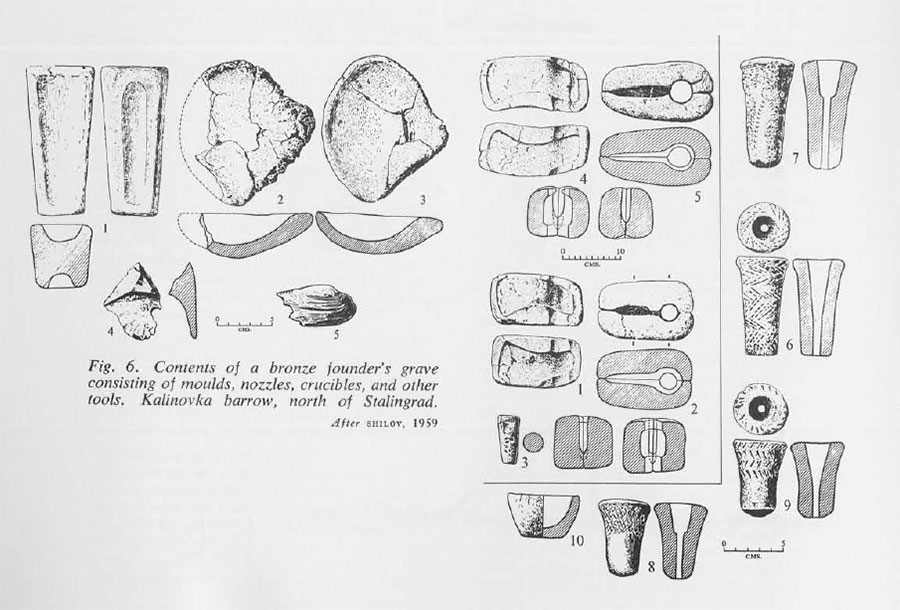
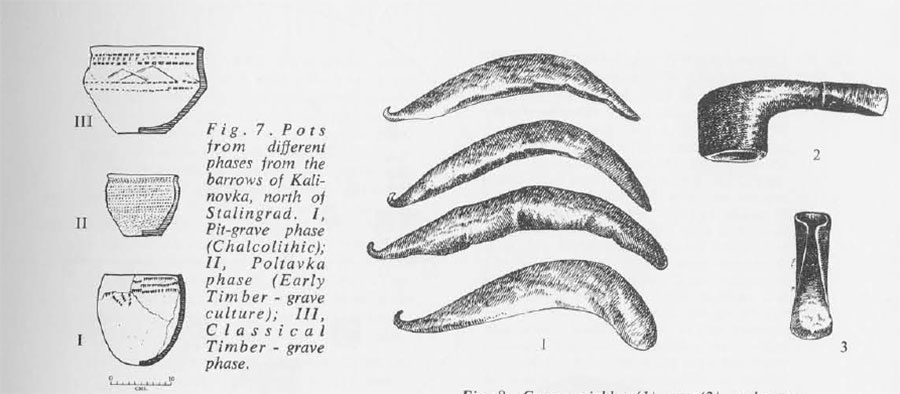

During the Classical Timber-grave period the horse appears as an important animal in both religious cult and military life. In graves and in habitation sites bridle parts, most frequently elongated cheek-pieces and round ornamental plates of bone, were found. Such round ornamental plates are illustrated here (Fig. 4) from the cemetery of Ilovatka, lower Volga area. They are decorated with a solar emblem in the center and a minute geometric ornament around the edges. Bridle parts were laid in men’s graves. But not merely cheek-pieces and round plates appear; burials are known of bridled horses at the side of chieftains’ graves. Associated with the horse burials at Komarovka in the district of Kuibyshev was found a cheek-piece–the only survival of the harness (Fig. 5). The horses, like the human beings, were buried with much care. Above one horse of the Komarovka barrow lay skulls of a cow, a calf, and a sheep. They were next to the earliest, centermost grave of the barrow, which must have belonged to an important person, probably a chieftain of the tribe.
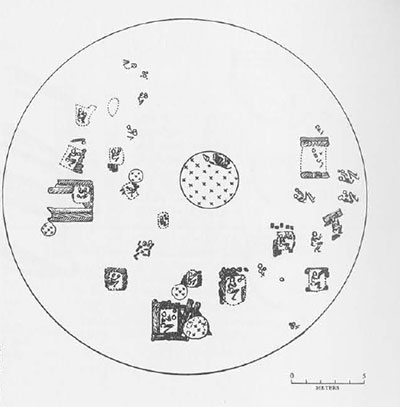


Human sacrifice was also practiced. Skulls and bones of adolescent individuals were found in fireplaces. There were many double or multiple graves of a man and a woman, a child and an adult, or several children. Collective graves of five or more, generally young people, occur. A number of these graves must have been connected with the sacrificial burials. Symbolic burials (cenotaphs) are a frequent occurrence in this culture. Inhumation was the typical burial method, but cremation was used by the same people at the same time, probably in connection with sacrificial procedures. Undoubtedly there was an elaborate system of burial practices determined by such factors as the social status, age, and sex of the deceased.
The evidence for the dating of the Timber-grave Culture, based on commercial relations and typological studies, shows that its duration covered the greater part of the second and the beginning of the first millennium B.C. Large groups of barrows, containing graves of different chronological phases, definitely indicate that the Timber-grave period lasted a long time. Most of the barrow cemeteries that yield evidence of a stratigraphic nature are from the lower Volga area around Stalingrad, Saratov, and Kuibyshev. There are also habitation sites of different periods found in one small area. Changes in type of copper artifacts, of pottery, and of burial rites, together with the stratigraphic evidence, make it possible to discern five consecutive chronological phases.
Early Timber-grave Culture, about 1900-1700 B.C.
The Early Timber-grave Culture is also known as the “Poltavka Culture” or the “Poltavka Period,” after the cemetery at Staraia Poltavka near Saratov. During this period local metallurgy appeared, as shown by graves of metallurgists equipped with moulds, nozzles, crucibles, and hammers, as for instance, the grave contents from the barrow of Kalinovka, north of Stalingrad shown in Fig. 6. The usual copper artifacts were axes, awls, knives, spiral ornaments and beads. Instead of the round-based pots of the Neolithic and Chalcolithic Ages, small flat-based pots with rounded sides, decorated all over with impressions of a dentate stamp or cord, were now used (Fig. 7). Burial rites continued much as in Chalcolithic times. Typical were large semi-spherical barrows covering large rectangular pits with the remains of timber roofing. Cultures in Russia and central Europe at this time were: Middle Kuban in the northern Caucasus, the late Catacomb-grave Culture north of the Azov and Black Seas, Fatianovo in central Russia, Proto-Unetice in central Europe, Late Corded Culture north of the Carpathians and in the Baltic area.
Classical Timber-grave Culture, about 1700-1100 B.C.
The distinctive elements of this period are its metallurgical progress, its biconically shaped and geometrically decorated pottery, and timber-graves in the barrows. Three successive phases, A, B, and C, may be differentiated on the basis of gradually changing metal forms, pottery, and burial rites.
Phase A, or Klevka (after a site near Zemliansk, district of Voronezh) in ceramic art and burial rites is transitional between the preceding Early Timber-grave period, and the following Pokrovsk Phase. the number of copper axes and sickles increases (Fig. 8), pots tend to become biconical in form, and real house-graves built of oak or birch planks appear. The phase is one of the least explored. It parallels in time the classical Unetice of central Europe and the Usatovo Culture northwest of the Black Sea, and should be dated to the period between 1700 and 1500 B.C.
Phase B, or Pokrovsk (after the cemetery of Pokrovsk near Saratov) is the best represented and is distinctive in its extensive commercial relations. Through the wide spread o
f spearheads, axes, daggers, and broad-bladed knives (Fig. 9) it can be synchronized with the central east Russian Seima and Turbino Phase, with the Alekseevskoe Phase of the Andronovo Culture in southern Siberia, with the Monteoru II Phase of Moldavia, with the expansion and formation period of the Tumulus Culture in western central Europe (Phase B1 and B2), and with the Kamarov Phase north of the Carpathians. In round dates it should be placed between 1500 and 1300 B.C. Biconical forms of pots were predominant and the impressed or incised ornament was now more varied (Fig. 9). Graves were timber-roofed under a circular barrow. Villages and houses continued to be small. During this phase the Timber-grave people expanded into central Russia as far as the upper and middle Oka River.
Phase C, or Yagodnow (after a cemetery near Kuibyshev). The pottery style continued, but changes appeared in the burial rites. So-called “barrow cemeteries” appeared, in which members of one kin-group were buried, covered by a flat mound (Fig. 10). Timber houses in graves were solidly built of oak beams and planks, and were not much smaller than those in which people lived. Red ochre, previously found in the graves, now disappeared. Habitation areas and houses were larger than in preceding phases. Because of its position following the Pokrovsk, the Yagodnoe Phase must be dated to the thirteenth and twelfth centuries B.C.
Late Timber-grave Culture, about 1100 B.C. to the beginning of the Scythian era
This was a warlike period. Habitation sites are found on the highest river terraces with good protection from the water. Houses were large (Fig. 11). The pottery was very simple, decorated with rows of incisions and ridged ornament. Timber funerary houses and ochre graves almost disappear.
During this period the Timber-grave people expanded to the west, to the lower Dnieper and lower Dniester basins. All over the area between the Dniester and the Volga and beyond the Volga to the east, artifacts of the Timber-grave character are distributed. They are known as the Sosnovaia Maza type after a famous hoard found in Sosnovaia Maza near Saratov (Fig. 12). Although not as many sites from the Late Timber-grave period have been excavated as from the Classical period, nevertheless, they suffice to illustrate a florescence of metallurgy and an expansion into the Ukraine.
The presence of a powerful, constantly expanding culture in South Russia at the end of the second and the beginning of the first millennium B.C. offers a solution to the problem of the movements of Kimmerians and Scythians. The archaeological finds in the area do not indicate the appearance of an entirely new culture from Asia in the eighth century B.C. Instead, there was a gradual persistence of culture from the Late Bronze Age to the Early Iron Age period in southern Russia. Who but the Timber-grace people could have ousted the Kimmerians from the Black Sea coast at the end of the eighth century B.C.?
